Analysis on Environmental Thermal Effect of Functionally Graded Nanocomposite Heat Reflective Coatings for Asphalt Pavement
Abstract
:1. Introduction
2. Materials and Methods
2.1. Materials
2.2. Temperature Measurement
2.3. Analysis on Environmental Heat Effect
2.3.1. Calculation of the Radiant Heat Effect of the Pavement
2.3.2. Calculation of the Heat Convection Effect of the Pavement
2.3.3. Analysis of the Thermal Environment of the Atmosphere Layer Near Pavement
2.3.4. The Influence of Urban Road on Human Thermal Comfort
3. Results and Discussion
3.1. Results of the Temperatures Measurement Tests
3.2. Analysis of Environmental Thermal Effect
3.2.1. Radiant Heat Effect
3.2.2. Convective Heat Transfer Effect
3.2.3. Comparative Analysis of Thermal Effects of Different Underlying Surfaces
3.3. Analysis of the Pavement Surface–Atmospheric Surface Layer–Thermal Environmental Influence on the Near-Ground Atmosphere
3.4. Analysis of OTCD
4. Conclusions
- Pavement can transfer heat to the ambient environment by radiation and convection. The temperature of the road surface plays a decisive role in the thermal effect. The radiation heat of all functionally graded nanocomposite heat-reflective coatings decreased by near two-thirds, and the convective heat decreased by near 50% in comparison to the control asphalt pavement. The functionally graded nanocomposite heat-reflective pavement reduced the environmental thermal effect, which was beneficial in relieving the urban heat island effect.
- The heating model was established to simulate asphalt pavement with and without functionally graded nanocomposite heat-reflective coatings to heat the atmosphere surface layer near the pavement. The temperature of the atmosphere surface layer was much higher than the ambient temperature. The functionally graded nanocomposite heat-reflective asphalt pavement reduced the temperature of the pavement itself and the atmosphere surface layer near the pavement.
- Under certain conditions, outdoor thermal comfortable degree (OTCD) increases linearly with the increase of temperature, while human thermal comfort decreases with the increase of temperature and OTCD. The OTCD values of the functionally graded nanocomposite heat-reflective coatings were reduced compared to those of the control asphalt pavement. Therefore, the functionally graded nanocomposite heat-reflective asphalt pavement improves human thermal comfort.
Author Contributions
Funding
Conflicts of Interest
References
- Rosenfeld, A.H.; Akbari, H.; Bretz, S.; Fishman, B.L.; Kurn, D.M.; Sailor, D.; Taha, H. Mitigation of urban heat islands: materials, utility programs, updates. Energy Build. 1995, 22, 255–265. [Google Scholar] [CrossRef]
- Sha, A.; Liu, Z.; Tang, K.; Li, P. Solar heating reflective coating layer (SHRCL) to cool the asphalt pavement surface. Constr. Build. Mater. 2017, 139, 355–364. [Google Scholar] [CrossRef]
- Cao, X.J.; Liu, P.; Li, R.J.; Liu, Y.G. Research progress on heat-reflective coatings applied to asphalt pavement. Electroplat. Finish. 2016, 35, 943–948. [Google Scholar]
- Cao, X.; Li, R.J.; Yang, X.Y. Preparation and performance evaluation of epoxy-based heat-reflective coating for the pavement. New Chem. Mater. 2016, 44, 140–143. (In Chinese) [Google Scholar]
- Zheng, M.L.; He, L.T.; Gao, X.; Wang, F.; Cheng, C. Analysis of heat-reflective coating property for asphalt pavement based on cooling function. J. Traff. Transp. Eng. 2013, 13, 10–16. [Google Scholar]
- Zhang, X.; Kong, Y.J.; Guan, Y.B. Analysis of the Effect of Asphalt Pavement on Heating Community Atmosphere. J. Jinling Inst. Technol. 2006, 22, 16–18. (In Chinese) [Google Scholar]
- Takashi, A.; Vu, T.C.; Akio, W. Heating of paved ground and its effects on the near surface atmosphere. Exchange Processes at the Land Surface for a Range of Space and Time Scales. In Proceedings of the Yokohama Symposium, Yokohama, Japan, 13–16 July 1993; IAHS Press: Wallingfor, UK; pp. 181–187. [Google Scholar]
- Liang, M.J. Asphalt Pavement Light Thermal Reaction Mechanism and Heat-Reflection Coating Engineering Research. Ph.D. Thesis, Harbin Institute of Technology, Harbin China, 2006. [Google Scholar]
- Munei, H.; Jizhong, B.; Shenjiang, D. Study on Improvement Effect on Urban Thermal Environment by Heat Insulating Pavement. In Proceedings of the 25th Japan Road Conference, Tokyo, Japan, 5–7 November 2003. (In Japanese). [Google Scholar]
- Pomerantz, M.; Akbari, H.; Chen, A.; Taha, H.; Rosenfeld, A.H. Paving Materials for Heat Island Mitigation, LBNL-38074; Lawrence Berkeley National Laboratory: Berkeley, CA, USA, 1997. [Google Scholar]
- Feng, D.C.; Zhang, X. Brief introduction of urban pavement alleviating urban heat island effect. J. China Foreign Highw. 2010, 4, 103–105. (In Chinese) [Google Scholar] [CrossRef]
- Bretz, S.; Akbari, H.; Rosenfeld, A. Practical issues for using solar-reflective materials to mitigate urban heat island. Atmos. Environ. 1998, 32, 95–101. [Google Scholar] [CrossRef]
- Baneshi, M.; Maruyama, S.; Komiya, A. Comparison between aesthetic and thermal performances of copper oxide and titanium dioxide nano-particulate coatings. J. Quant. Spectrosc. Radiat. Transf. 2011, 112, 1197–1204. [Google Scholar] [CrossRef]
- Synnefa, A.; Karlessi, T.; Gaitani, N.; Santamouris, M.; Assimakopoulos, D.N.; Papakatsikas, C. Experimental testing of cool colored thin layer asphalt and estimation of its potential to improve the urban microclimate. Build. Environ. 2011, 46, 38–44. [Google Scholar] [CrossRef]
- Zheng, M.; Han, L.; Wang, F.; Mi, H.; Li, Y.; He, L. Comparison and analysis on heat reflective coating for asphalt pavement based on cooling effect and anti-skid performance. Constr. Build. Mater. 2015, 93, 1197–1205. [Google Scholar] [CrossRef]
- Cheng, C. Preparation and Performance Evaluation of Solar Heat Reflective Coating on Asphalt Pavement. Master’s Thesis, Chang’an University, Xi’an, China, 2012. (In Chinese). [Google Scholar]
- He, L.T. Research of the Environmental Effects and Construction Technology of Thermal Reflective Asphalt Pavement. Master’s Thesis, Chang’an University, Xi’an, China, 2013. (In Chinese). [Google Scholar]
- Iwama, M.; Yoshinaka, T.; Omoto, S.; Nemoto, N. Applicability of solar heat blocking pavement technology to permafrost regions. In Proceeding of the ASCE 2012-Cold Regions Engineering 2012: Sustainable Infrastructure Development in a Changing Cold Environment, Quebec City, QC, Canada, 19–22 August 2012. [Google Scholar]
- Zhang, J.Z.; Chang, H.P. Heat Transfer, 2nd ed.; Science Press: Beijing, China, 2015. (In Chinese) [Google Scholar]
- ANSYS Version 18.0; ANSYS, Inc.: Canonsburg, PA, USA, 2017.
- Qian, W.; Qian, W.; Tang, M.F.; Zheng, H.L. Thermal Comfort Research of Urban Outdoor Environment. Chongqing Environ. Sci. 2002, 24, 88–89. (In Chinese) [Google Scholar]
- Qian, W.; Tang, M.F. Modeling of evaluation metropolitan outdoor thermal comfortable degree. J. Xi’An Univ. Arch. Technol. 2001, 33, 229–232. (In Chinese) [Google Scholar]
- Yan, Z.R. Analysis of the temperature field in layered pavement system. J. Tongji Univ. 1984, 16, 76–85. [Google Scholar]
- Jin, T.R.; Yan, Z.R. Investigations on the temperature conditions of cement concrete pavements. J. Tongji Univ. (Nat. Sci. Ed.) 1980, 3, 88–98. (In Chinese) [Google Scholar]
- Jordan, P.G.; Thomas, M.E. Prediction of Cooling Curves for Hot-Mix Paving Materials by a Computer Program; Transport and Road Research Laboratory (TRRL): Berkshire, UK, 1976. [Google Scholar]
- Corlew, J.S.; Dickson, P.F. Methods for calculating temperature profiles of hot-mix asphalt concrete as related to the construction of asphalt pavements. Assoc. Asphalt Paving Technol. Proc. 1968, 37, 101–140. [Google Scholar]
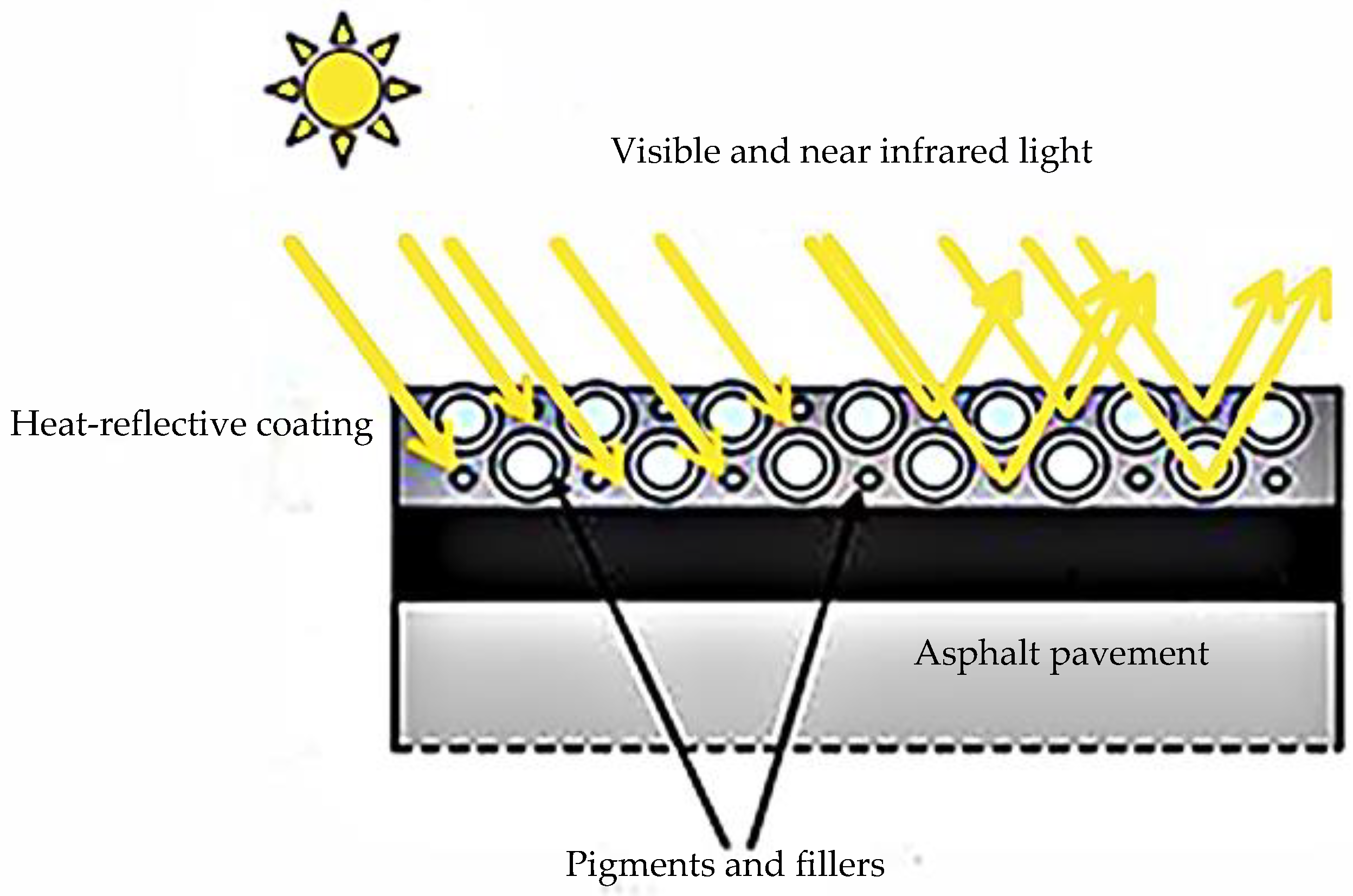
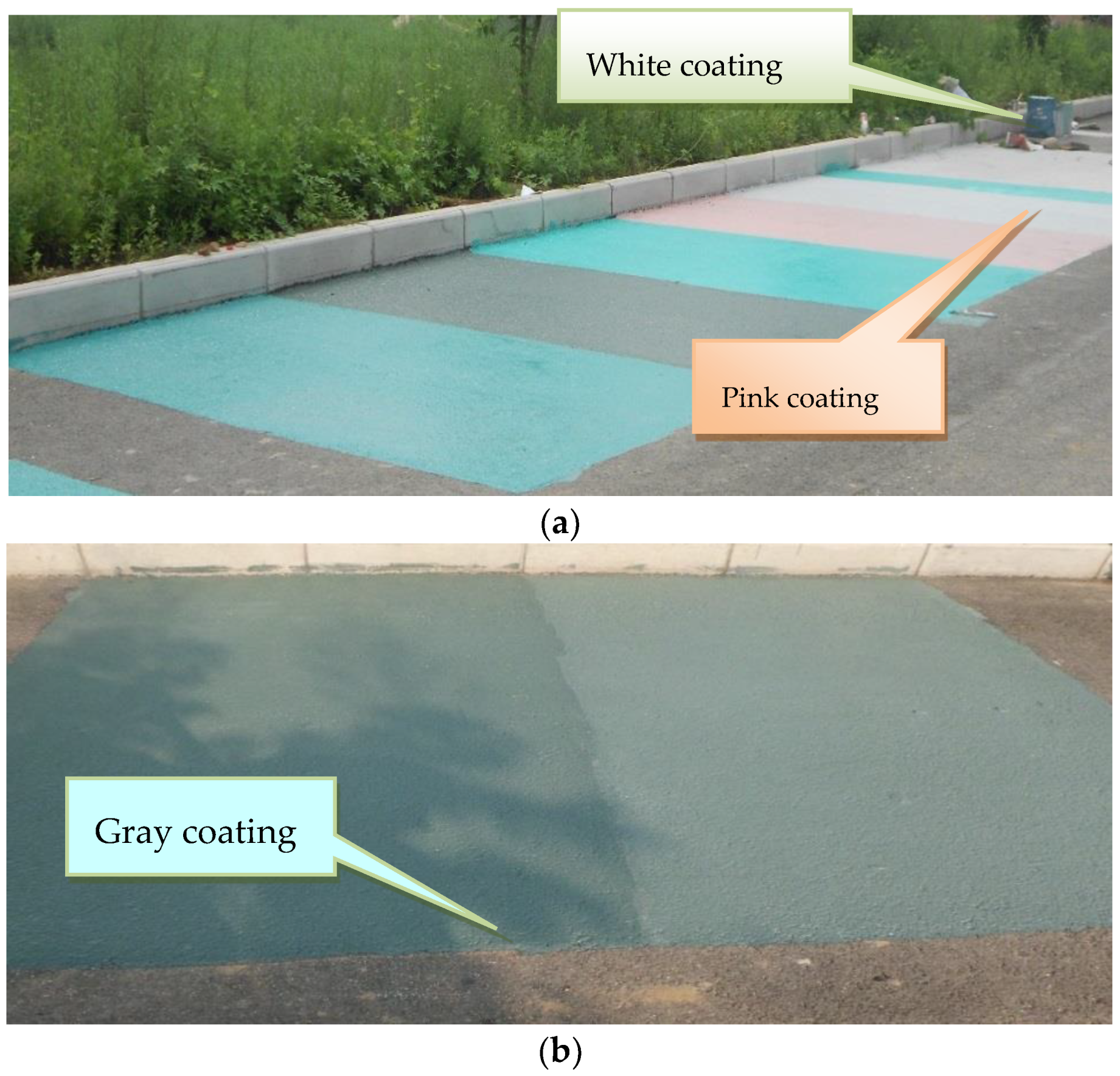
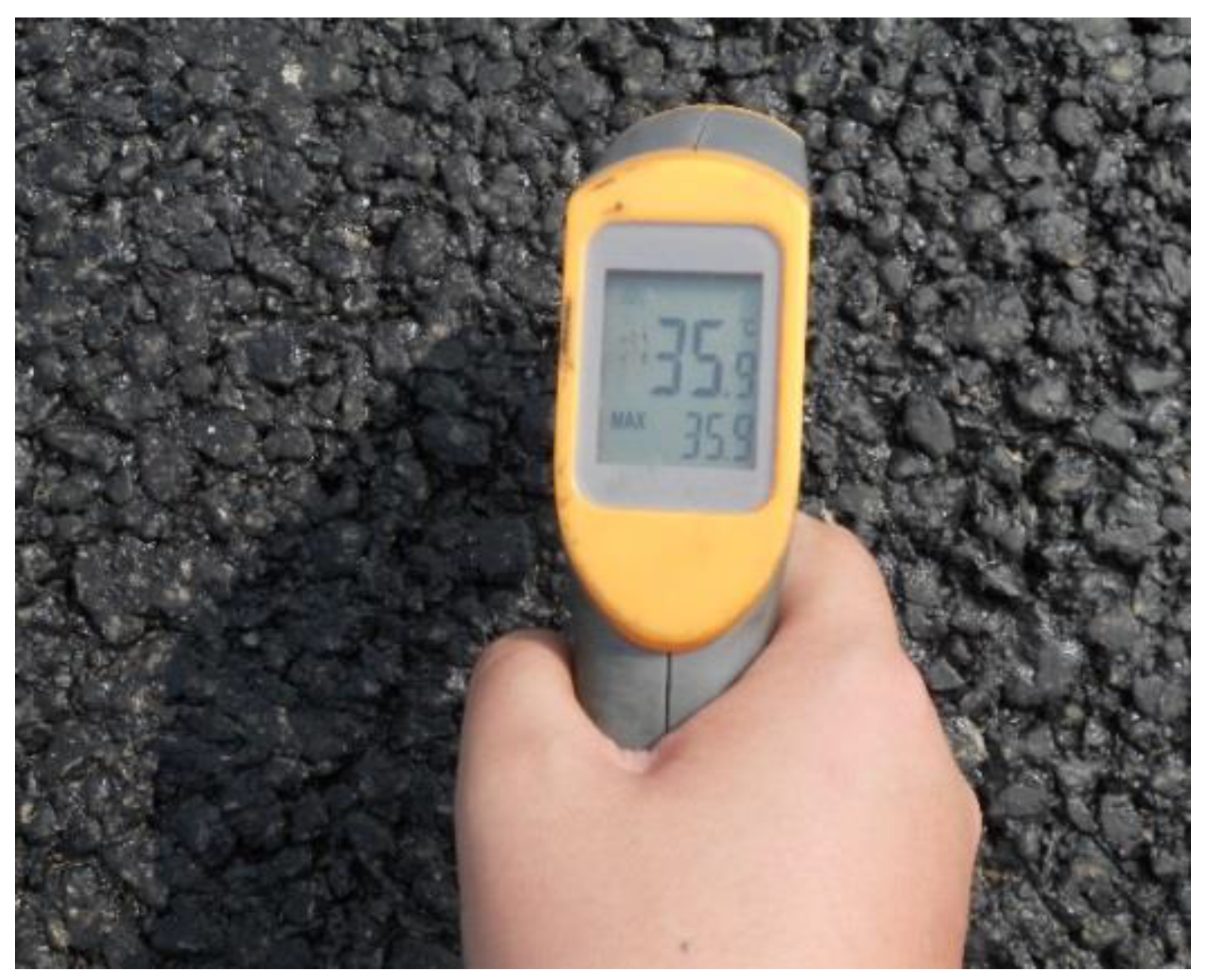
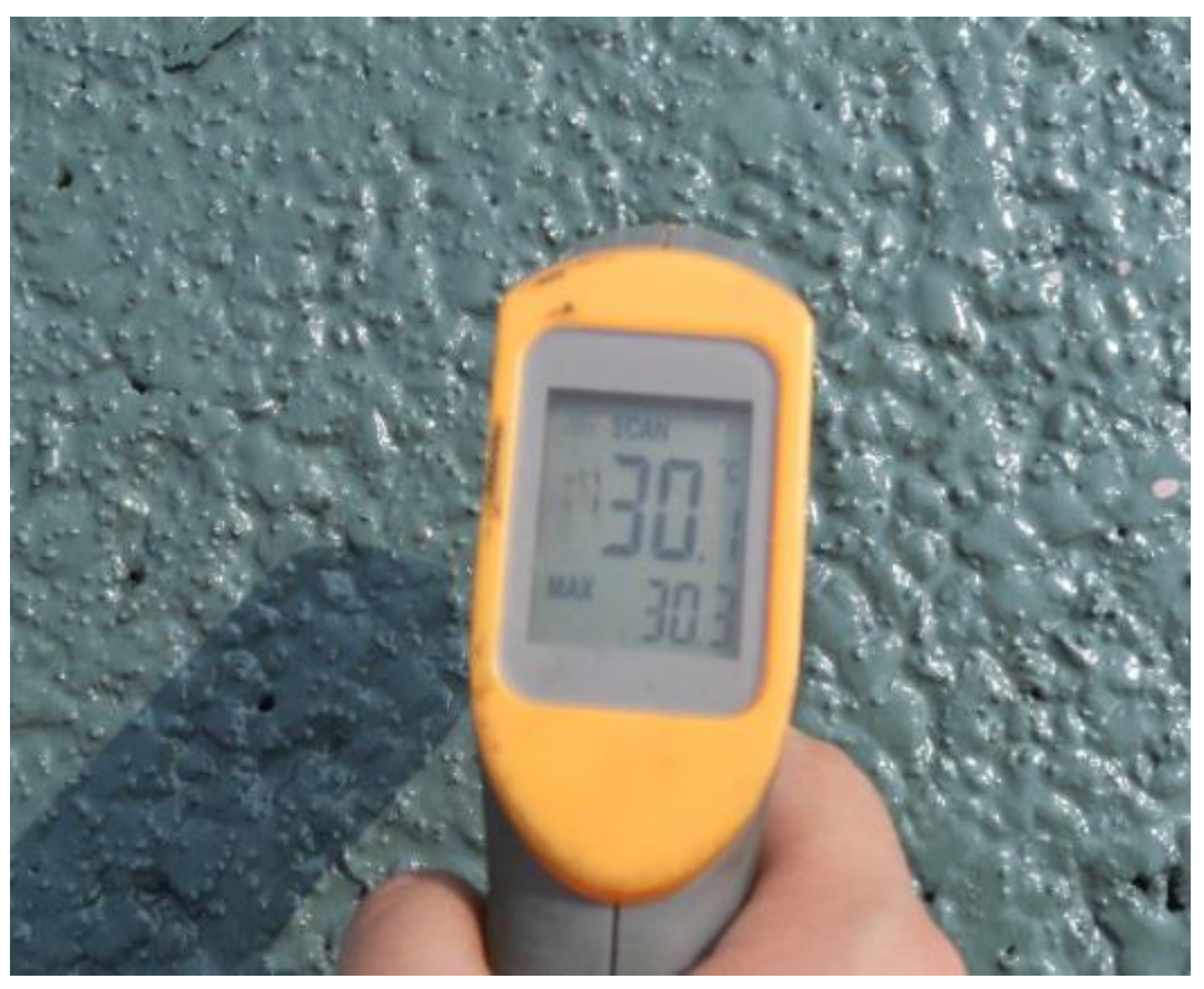
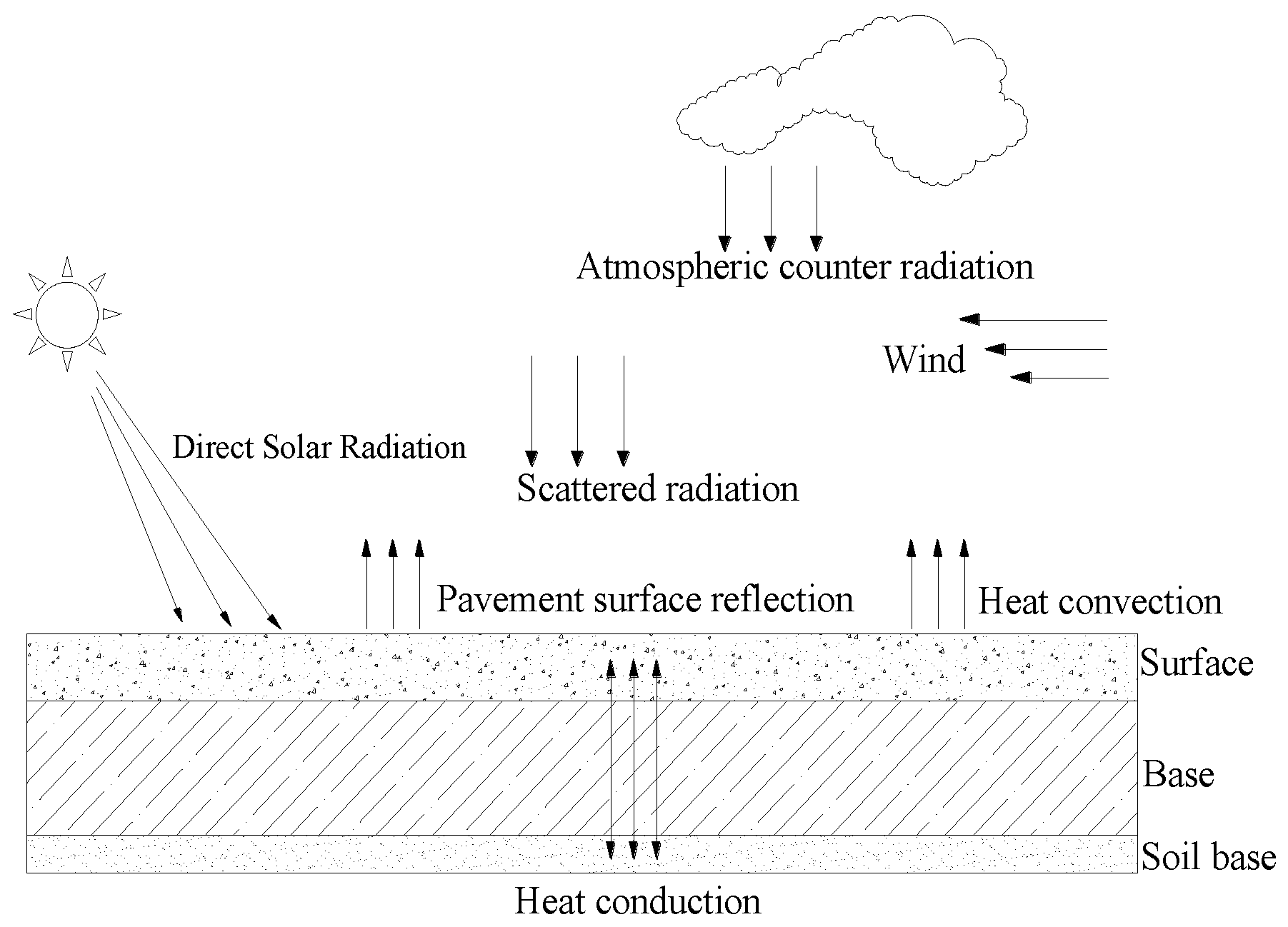

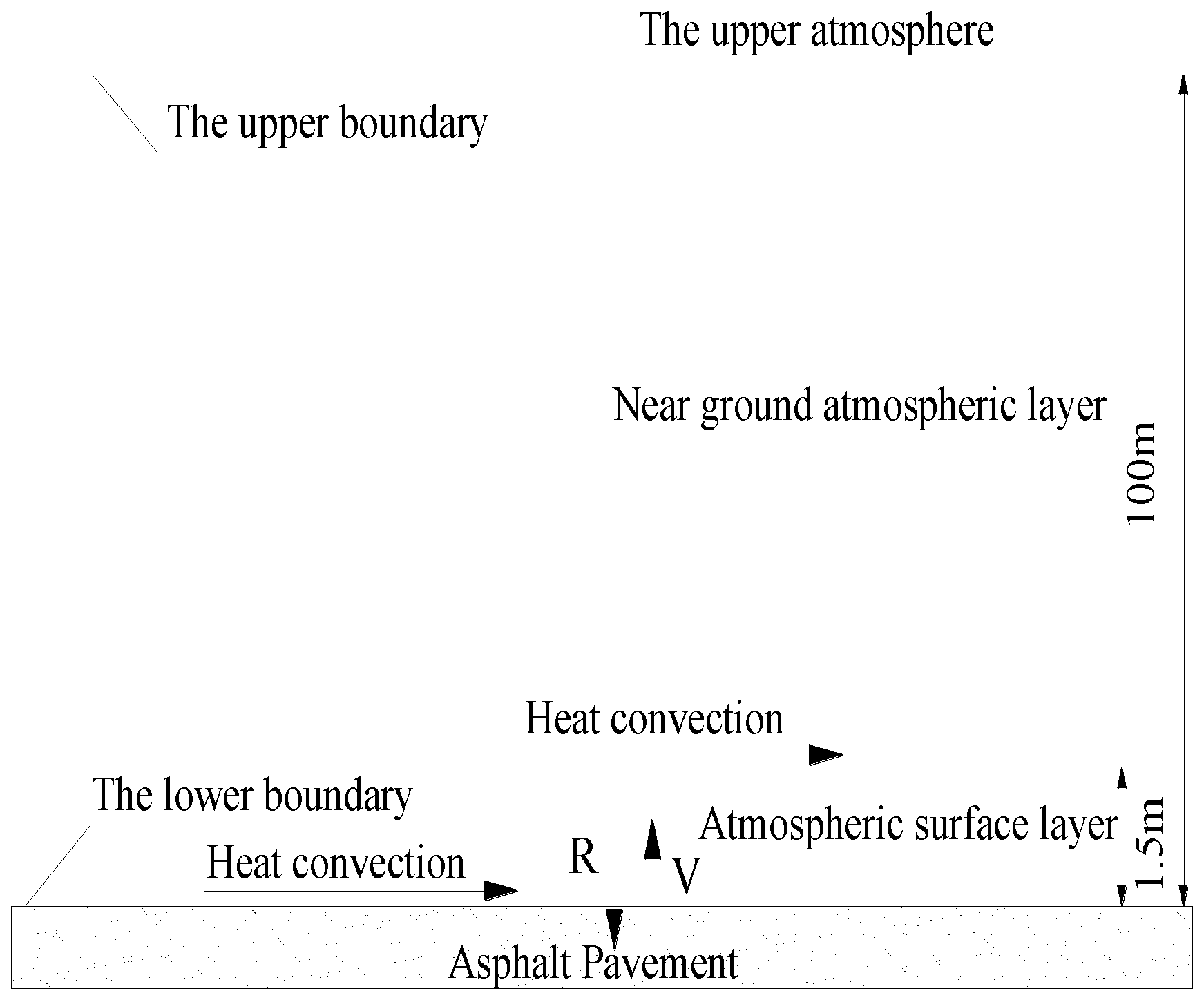
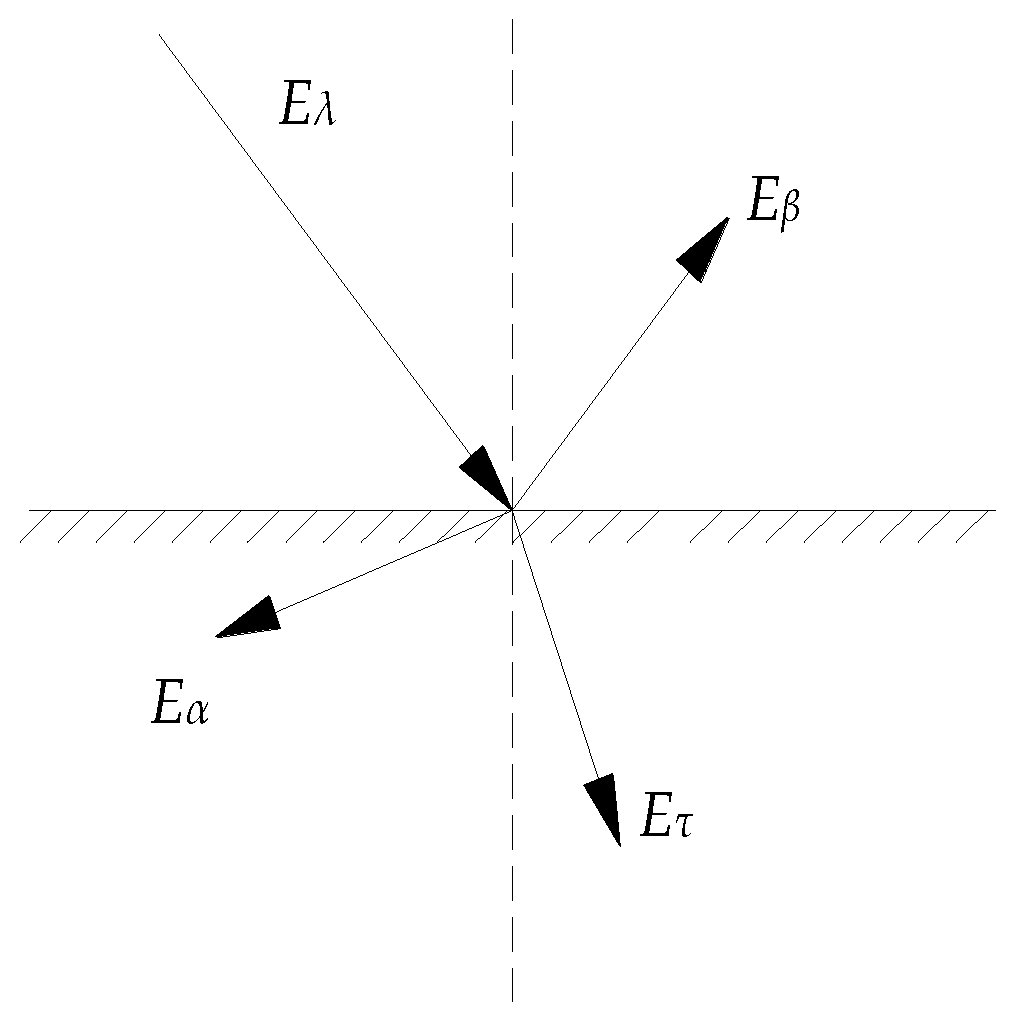
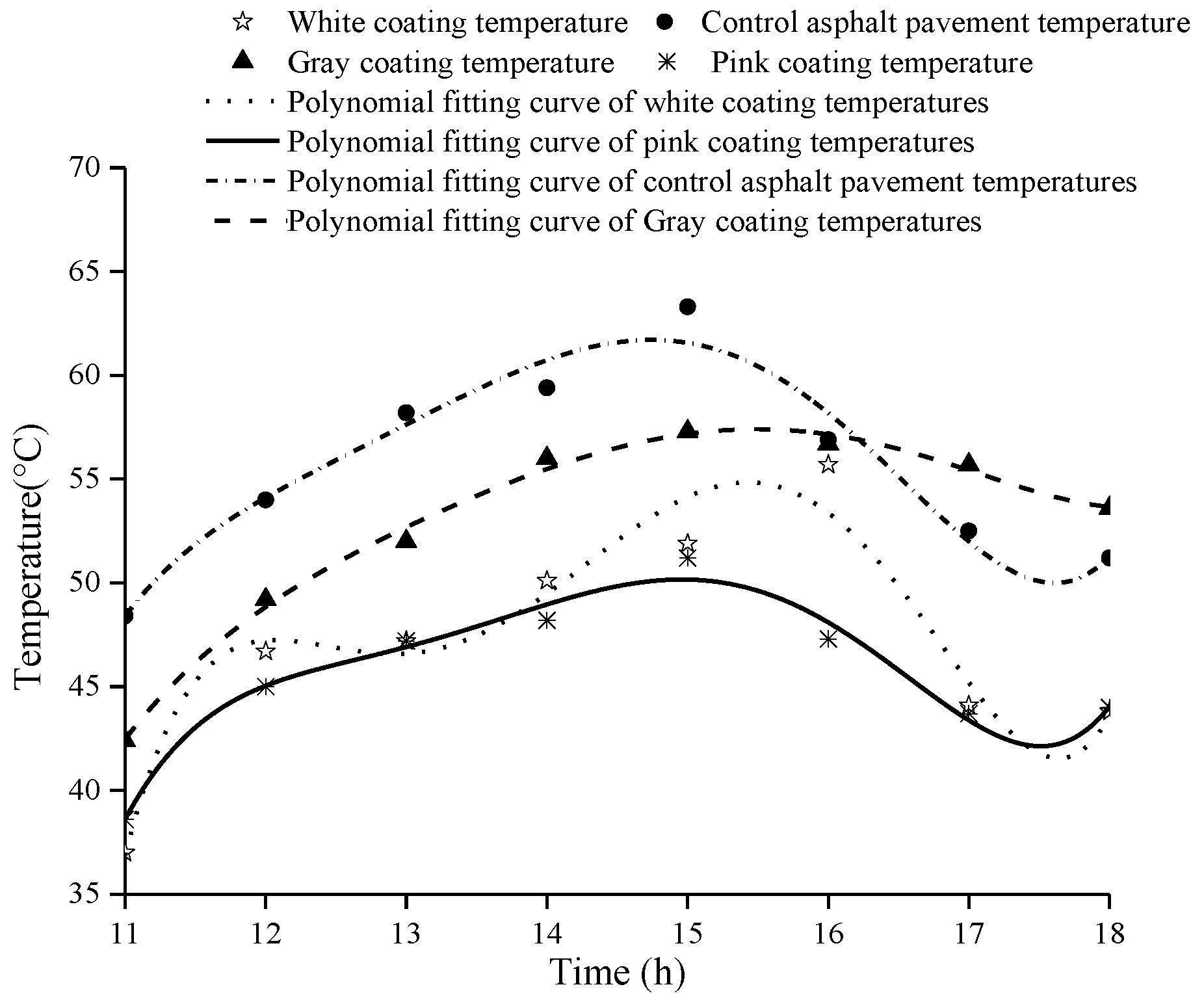
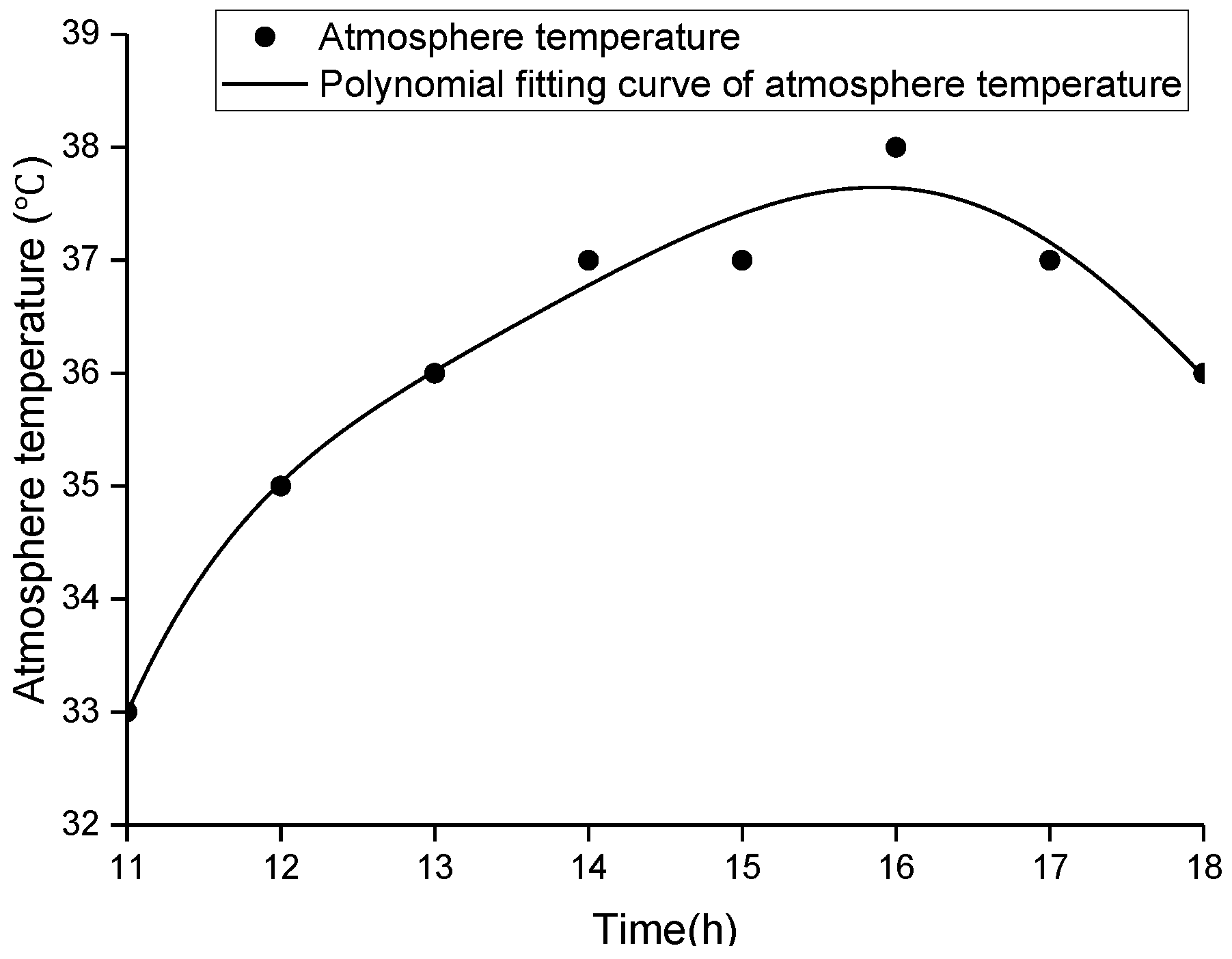
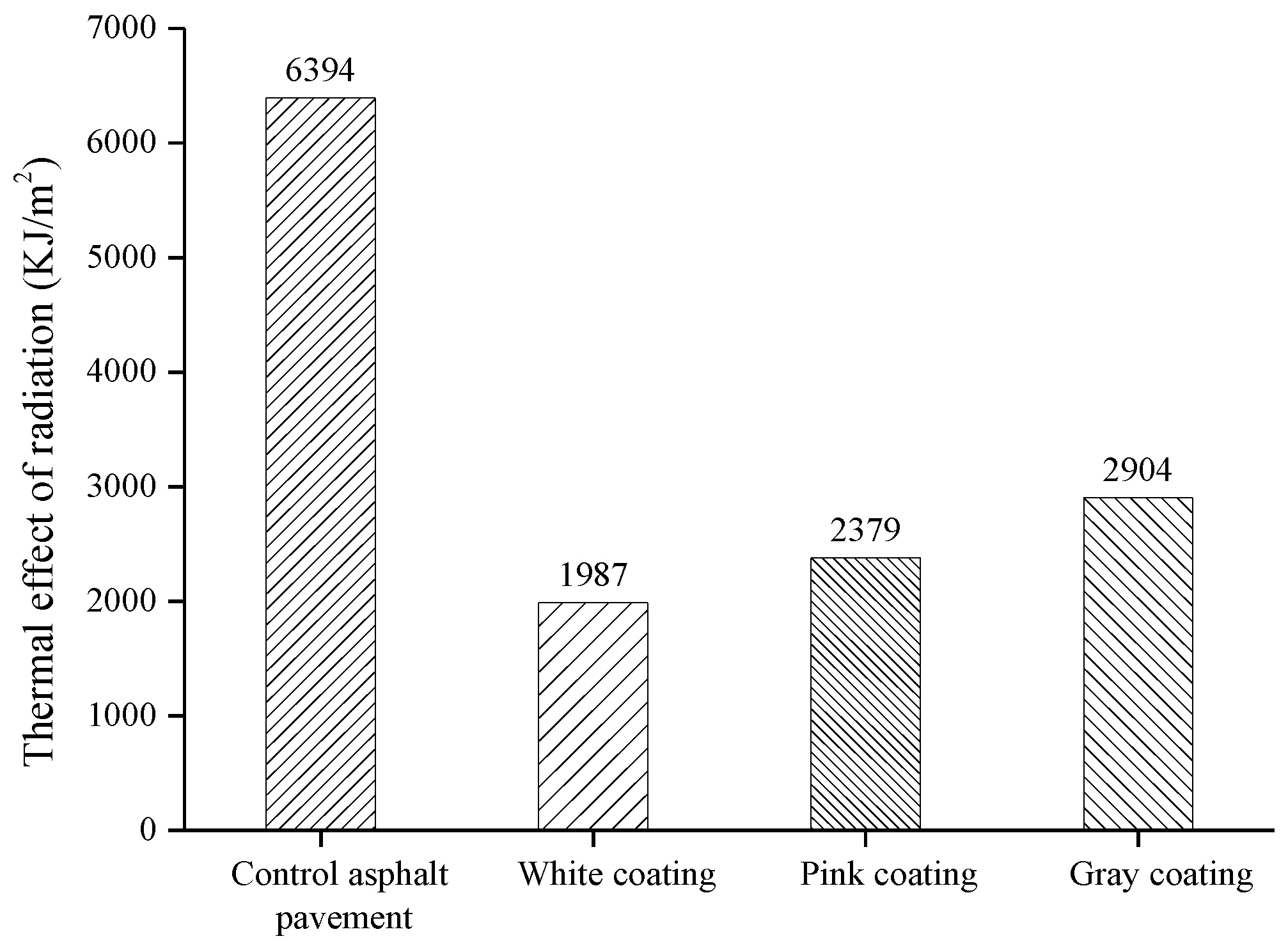
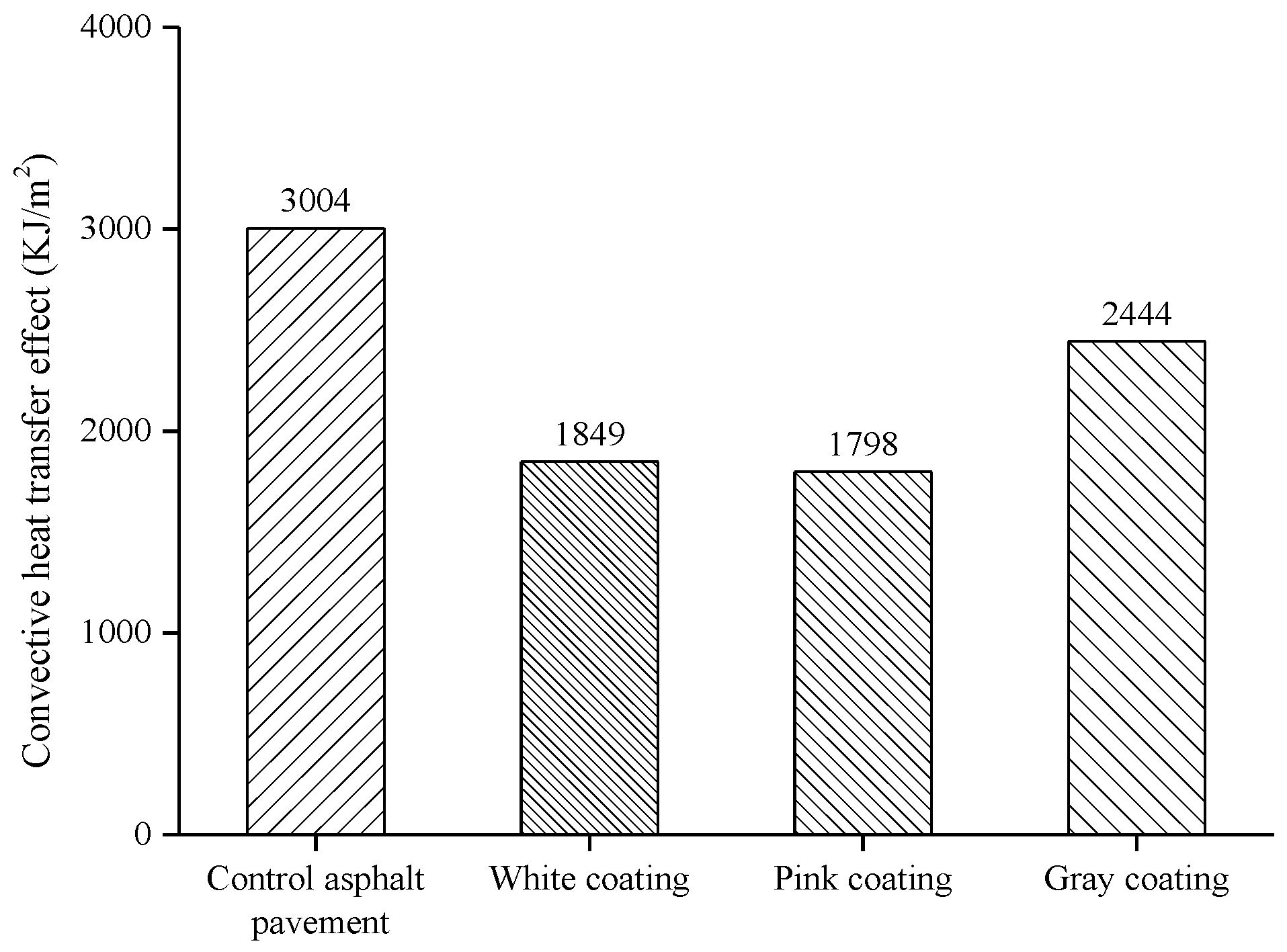
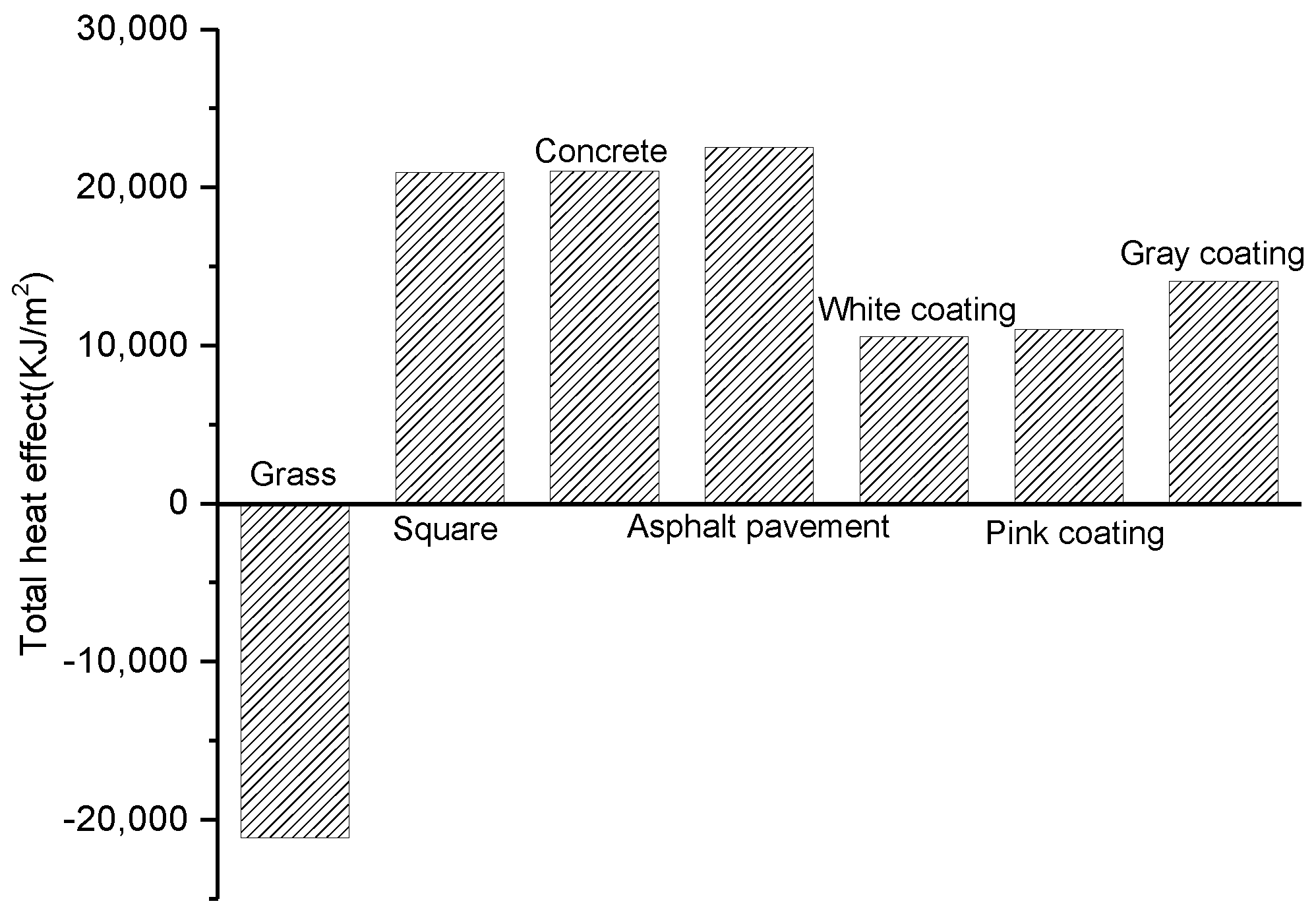
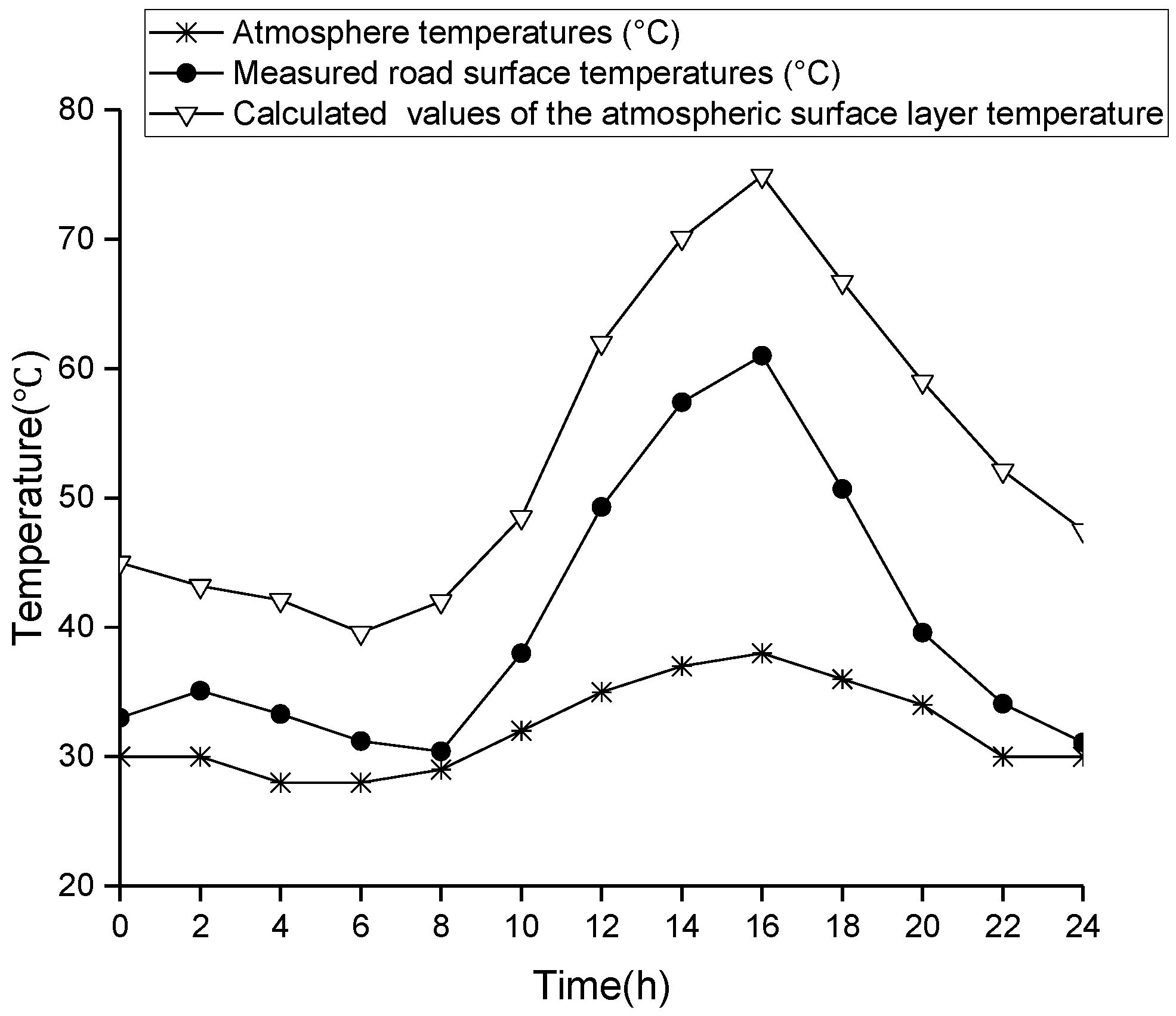
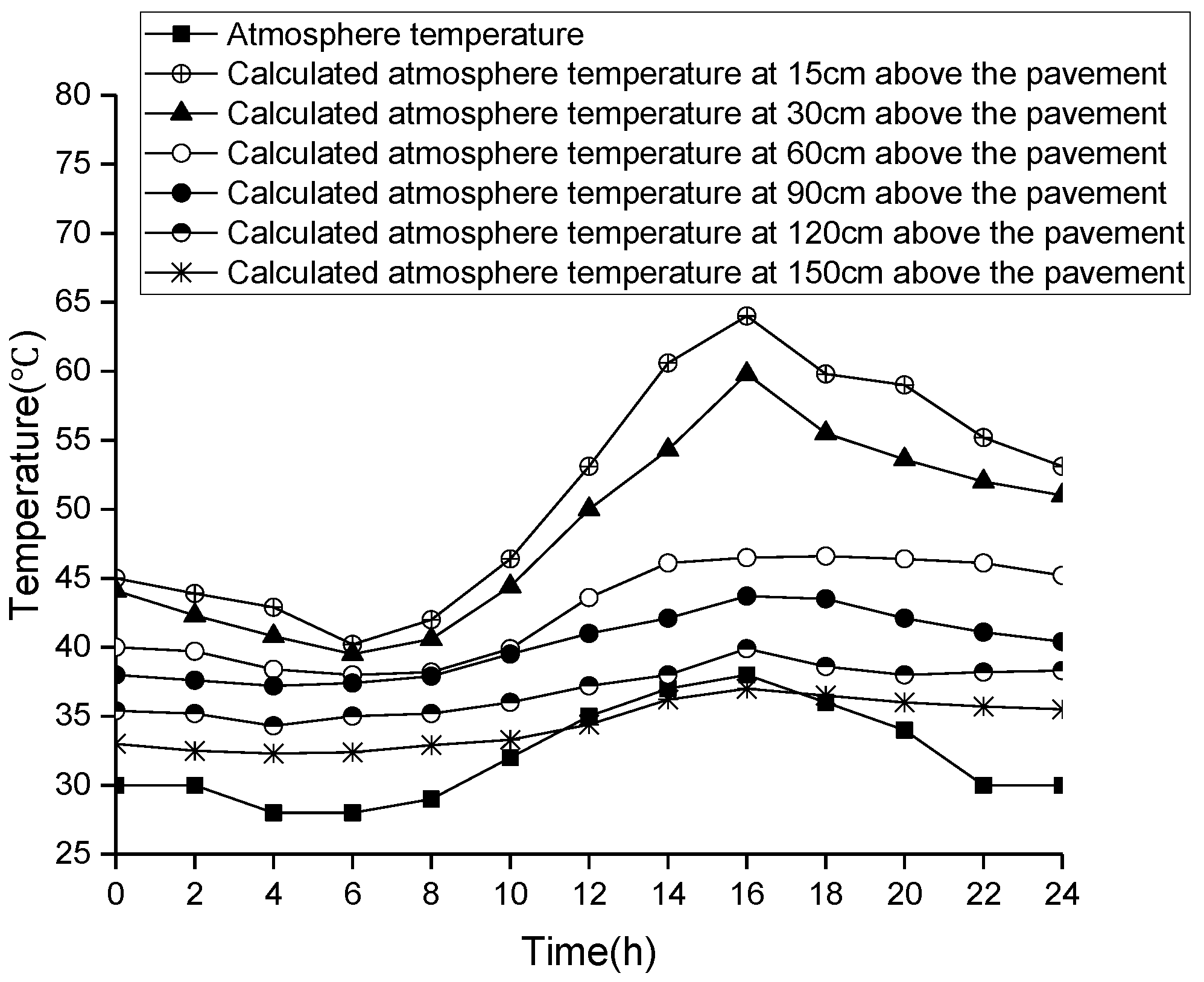
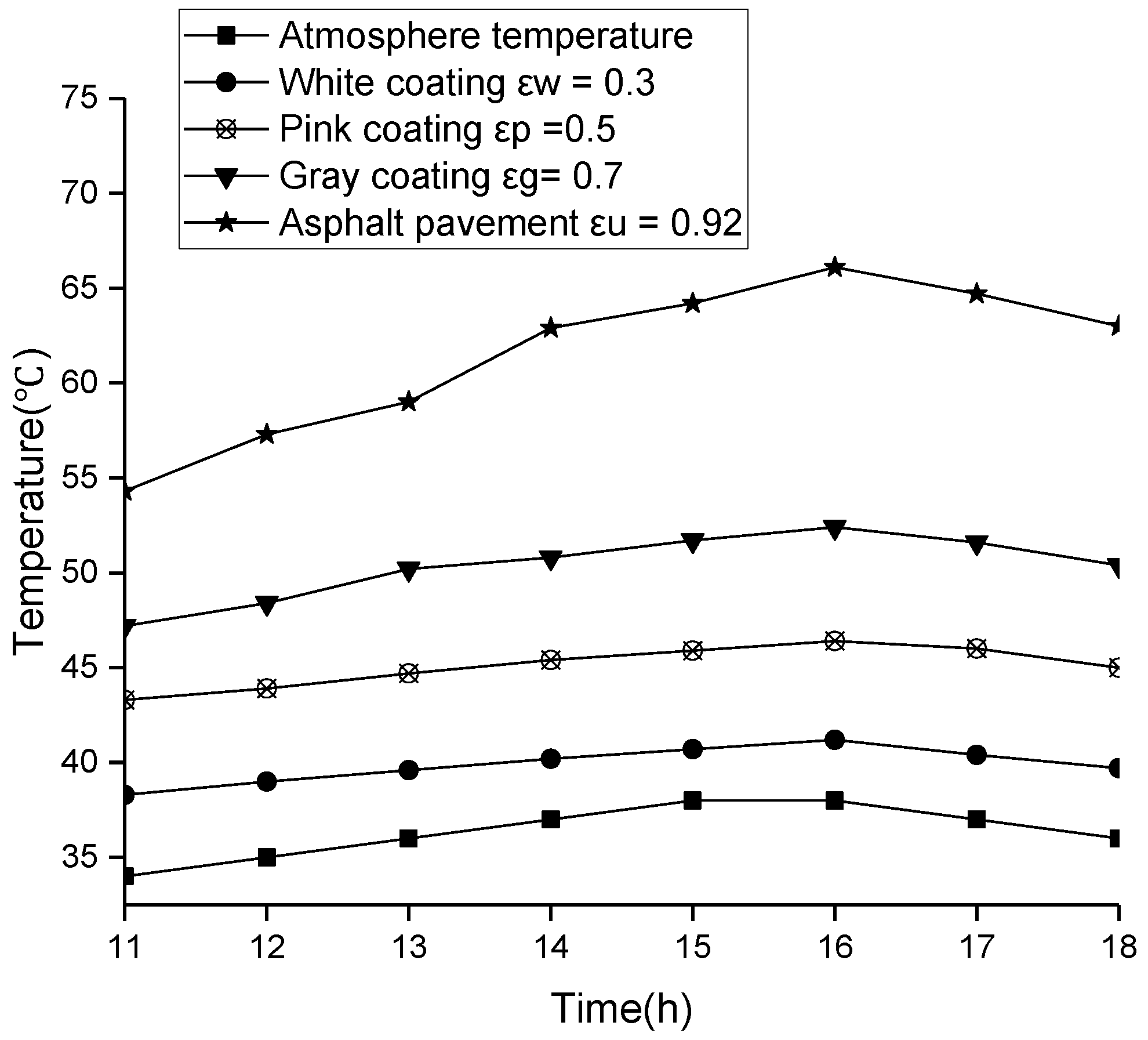
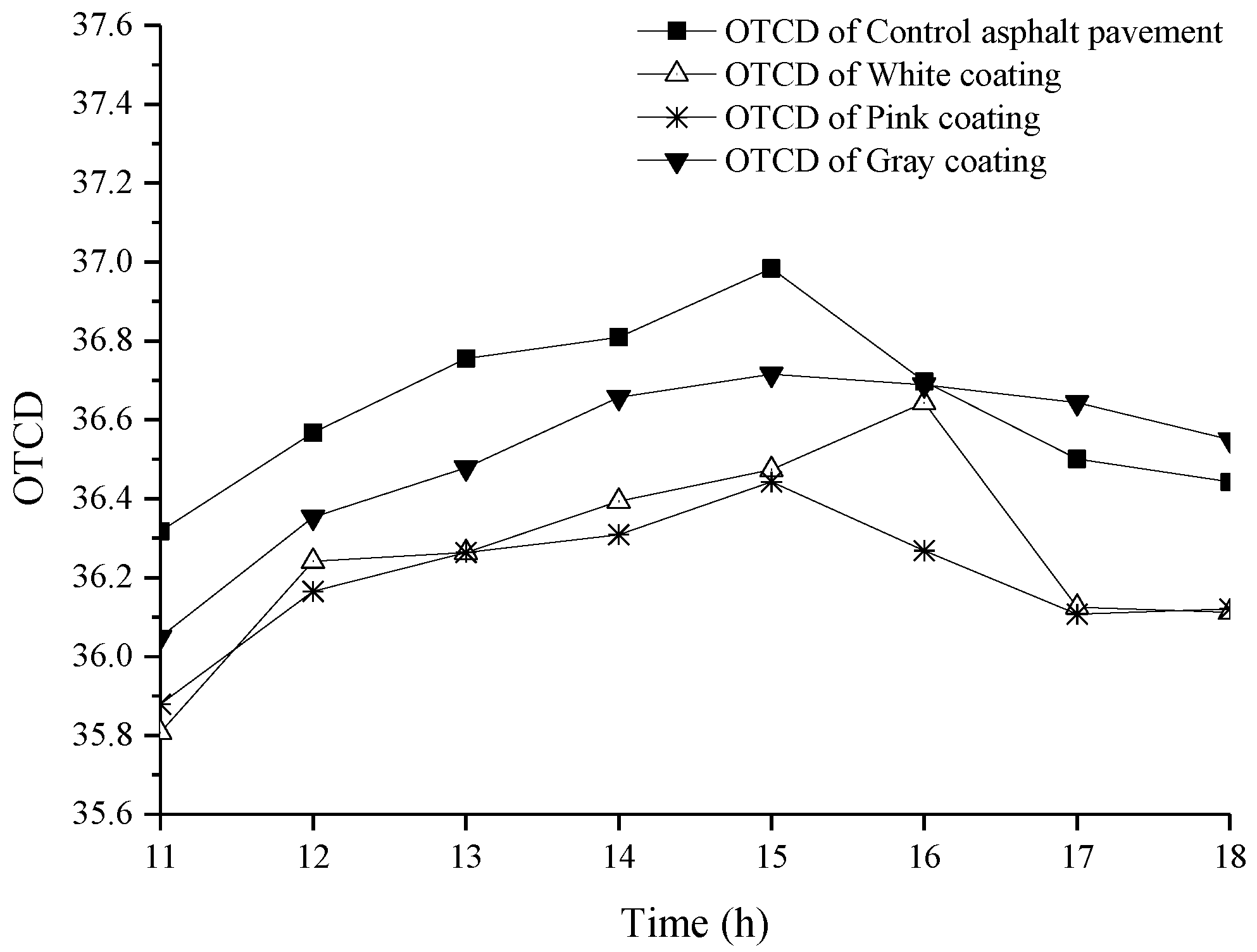
| Materials | Main Ingredients |
|---|---|
| The resin system | Modified liquid bisphenol-A epoxy resin X |
| Functional materials | Reflective material: Nanotitanium dioxide Insulation material: Floating beads Radiation material: Mica |
| Pigments | Organic green, organic black, inorganic red, inorganic black |
| Dispersant | Polyethylene glycol |
| Antisettling agent | Polyamide wax |
| Initiating agent | 2,2′-Azobis(2-methylpropionitrile) |
| Resin Type | Epoxy Resin |
|---|---|
| Appearance | Colorless or light yellow, transparent liquid |
| Color (Gardiner method) | <2 |
| Density (g/mL,25 °C) | 1.10–1.12 |
| Viscosity (25 °C, mPa·s) | 9000–13000 |
| Epoxide equivalent (g/ep) | 184–194 |
| Colors | Reflectivity |
|---|---|
| White | 0.7 |
| Pink | 0.5 |
| Gray | 0.4 |
| Parameters | Value | Unit |
|---|---|---|
| Density | 1.29 | kg/m3 |
| Heat conductivity | 0.0265 | W/m·k |
| Specific heat capacity | 0.24 | kcal/kg·°C |
| Convective heat transfer coefficient (between road surface and atmosphere) | 18 | W/m2·k |
| Convection heat transfer coefficient (flow atmosphere between layers) | 20 | W/m2·k |
| Time (h) | Atmosphere Temperature (°C) | Road Surface Temperature (°C) |
|---|---|---|
| 0 | 30 | 39.1 |
| 2 | 30 | 37.4 |
| 4 | 28 | 36.3 |
| 6 | 29 | 37 |
| 8 | 30 | 44 |
| 10 | 32 | 48.2 |
| 12 | 35 | 54 |
| 14 | 37 | 56.9 |
| 16 | 38 | 59.4 |
| 18 | 36 | 56.9 |
| 20 | 34 | 51.2 |
| 22 | 30 | 42.1 |
| 24 | 30 | 38.5 |
| Time (h) | 11 | 12 | 13 | 14 | 15 | 16 | 17 | 18 |
|---|---|---|---|---|---|---|---|---|
| Atmosphere temperature | 33 | 35 | 36 | 37 | 37 | 38 | 37 | 36 |
| Control asphalt pavement | 48.4 | 54 | 58.2 | 59.4 | 63.3 | 56.9 | 52.5 | 51.2 |
| White coating | 37 | 46.7 | 47.2 | 50.1 | 51.9 | 55.7 | 44.1 | 43.8 |
| Pink coating | 38.6 | 45 | 47.2 | 48.2 | 51.2 | 47.3 | 43.7 | 44 |
| Gray coating | 42.4 | 49.2 | 52 | 56 | 57.3 | 56.7 | 55.7 | 53.6 |
© 2019 by the authors. Licensee MDPI, Basel, Switzerland. This article is an open access article distributed under the terms and conditions of the Creative Commons Attribution (CC BY) license (http://creativecommons.org/licenses/by/4.0/).
Share and Cite
Zheng, M.; Tian, Y.; He, L. Analysis on Environmental Thermal Effect of Functionally Graded Nanocomposite Heat Reflective Coatings for Asphalt Pavement. Coatings 2019, 9, 178. https://doi.org/10.3390/coatings9030178
Zheng M, Tian Y, He L. Analysis on Environmental Thermal Effect of Functionally Graded Nanocomposite Heat Reflective Coatings for Asphalt Pavement. Coatings. 2019; 9(3):178. https://doi.org/10.3390/coatings9030178
Chicago/Turabian StyleZheng, Mulian, Yanjuan Tian, and Litao He. 2019. "Analysis on Environmental Thermal Effect of Functionally Graded Nanocomposite Heat Reflective Coatings for Asphalt Pavement" Coatings 9, no. 3: 178. https://doi.org/10.3390/coatings9030178
APA StyleZheng, M., Tian, Y., & He, L. (2019). Analysis on Environmental Thermal Effect of Functionally Graded Nanocomposite Heat Reflective Coatings for Asphalt Pavement. Coatings, 9(3), 178. https://doi.org/10.3390/coatings9030178




